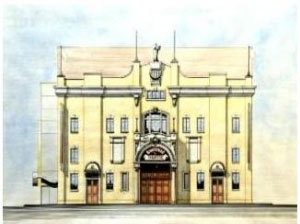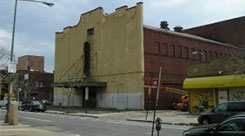Howard Theatre: A history
According to Cinema Treasures, the Howard Theater opened on August 22, 1910, in a primarily African-American area of Washington, near Howard University which lead to the theater’s name. It sat around 1,200 and was designed by architect J. Edward Storck and built for the National Amusement Company. During the mid-1920’s, it was sold to Abe Lichtman, a white theater owner of theaters that catered to African-Americans. As you can see from the vintage photograph (above left), it was billed as the “largest colored theater in the World.”
Its facade was a blend of several theater styles popular in the era, including Beaux-Arts, Neo Classical, and Italian Renaissance. At the top of the facade, overlooking T Street, was an over life-size statue of Apollo playing his lyre. The interior was even more extravagant, with a large balcony, eight boxes, a number of dressing rooms, and three entrances.
In its early years, the Howard Theater featured not only vaudeville, but live theater, musicals, and local talent shows. The theater was also home to two theatrical companies, the Lafayette Players and the Howard University Players. The picture above at right shows Pearl Bailey and her husband, drummer Louis Bellson, at the Howard Theatre on January 19, 1956 (Smithsonian Insitution Collection).
In 1929, with the collapse of the economy, the Howard Theater became a church for a couple years, before Shep Allen, a theater manager from Atlantic City reopened it in 1931 as a movie house and live entertainment venue, bringing in the newest and biggest names of the era in black entertainment, including Duke Ellington, a native Washingtonian, who played on the Howard’s grand reopening night. Allen also introduced the popular amateur night contests at the Howard, at which Ella Fitzgerald and Billy Eckstine appeared. Pearl Bailey made appearances onstage here in the 1940’s.
Other legendary performers, such as Sarah Vaughn, Dinah Washington, Sammy Davis, Jr., Lena Horne and Lionel Hampton played the Howard Theater during the 1940’s and into the 1950’s. During WW II, President and Mrs. Roosevelt attended balls at the Howard, which attracted Hollywood stars like Abbott and Costello, Cesar Romero, and Danny Kaye to perform.
In 1941, the Howard Theater underwent a massive remodeling, in Streamline style, complete with a new, sleek, facade and signage. During the 1950’s, the Howard Theater became a venue for rock and blues artists, and the audience switched from sophisticated, upper-and-middle class patrons to young adults and teenagers.
During the 1960’s, due to desegregation, and the 1968 riots, the Howard’s attendance began to decline, and the neighborhood around the theater began to grow more and more undesirable. The theater was shuttered in 1970. However, three years later, the Howard Theater Foundation was formed and funds were raised to refurbish the badly aging theater. The Howard Theater reopened in April 1975 (a year after being added to the National Register of Historic Places) with a highly anticipated night of live entertainment, including Red Foxx and Melba Moore. However, the theater closed again just weeks later, and was only used sporadically during the 1970’s and early 1980’s as a venue for live entertainment.

For many years, the Howard Theater sat vacant and in a state of disrepair. Currently, Howard Theatre Restoration, Inc. is raising capital to renovate the structure. According to the organization, inside and out, the new Howard Theatre will honor the glory of the past while ushering in an exciting future with new breath and energy. The rich legacy and the musical soul of The Howard will live on through the talents and performances of the hottest rising stars and superstars in the entertainment industry.




